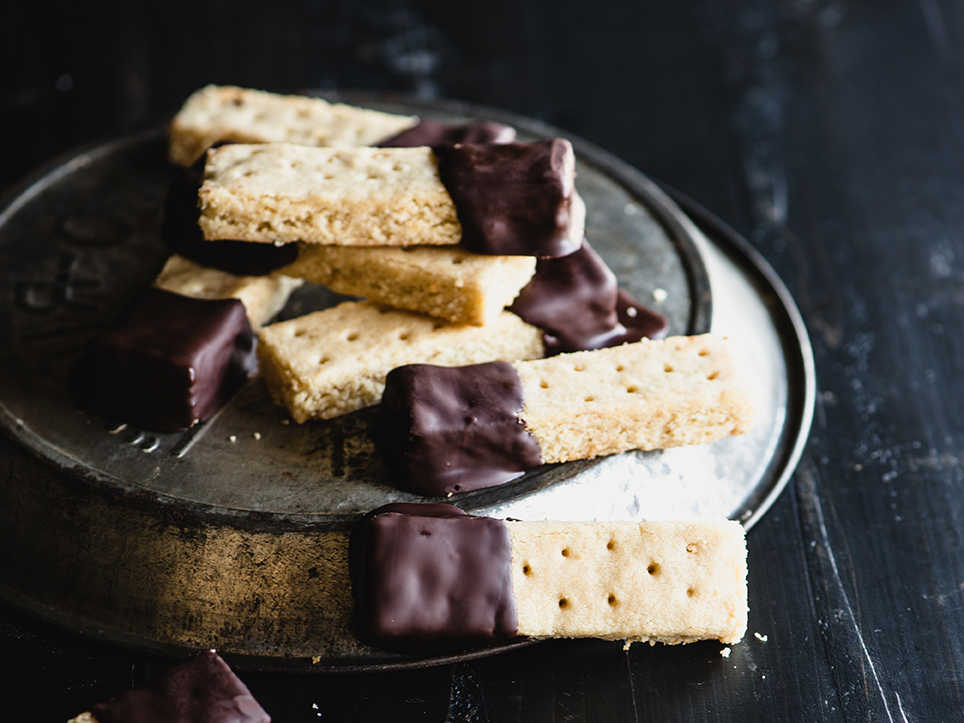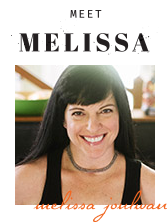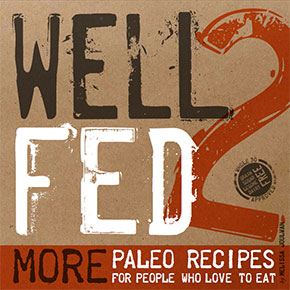You know how some people in dual-language households speak Spanglish (English + Spanish) – and at this time of year, lots of families celebrate both...
Read MoreGrain-Free Maple-Vanilla Shortbread
In each issue of Paleo Magazine, I team up with Steph Gaudreau to share the history of a traditional recipe and adapt it to fit into a healthier paleo lifestyle. (I write the words; she makes the gorgeous photos.) Just in time for the holidays, here’s the sweet and buttery history of Scottish shortbread.

Scottish Snashters
One of the highlights of recent paleo history is when the gurus collectively came to the conclusion that grass-fed ghee—butter that’s been clarified to remove the dairy proteins and leave only the luscious fat—is a paleo-friendly fat source. OMGhee! It’s a treat, indeed, to have butter back on the menu. And one of the butteriest ways to enjoy that singular, mildly salt, not-too-sweet flavor is in Scottish shortbread.
The very name shortbread is an homage to butter. Sweet treats—known in Scottish slang as snashters—are referred to as “short” when they’re made with lots of butter or shortening which imparts a crumbly texture. The shortbread cookie started out as a medieval biscuit made from leftover bits of bread dough that were fancied up with sugar and spices, then dried in a slow oven until they became crisp. Eventually, the yeast in the bread was replaced with butter and the bread became “short.”
But there was more to the name than semantics! Bakers pushed to have shortbread classified as a bread, rather than a biscuit, to avoid paying the taxes levied on biscuits in the fifteenth and sixteenth centuries. Fast forward to the 1980s, shortbread had become so popular, the European Union was in danger of reclassifying it as a “common biscuit” which would have made it subject to the cookie tax, but the Scottish Association of Master Bakers prevailed again, Shortbread remained a “flour confectionary” rather than a biscuit. Justice was once again served.
The first known printed recipe for shortbread dates from 1736—we thank ye, Mrs. McLintock! Now the generally accepted recipe for traditional shortbread is one part white sugar to two parts butter and three parts flour. But flavor variations have been popular as long as shortbread has been part of tea. According to scuttlebutt, Mary, Queen of Scots, liked her shortbread with a sprinkling of caraway (the way it’s made now in Goosnargh, Lancashire), while Queen Victoria preferred a pinch of salt. Other options include ginger, lemon, almond, and orange flavors.
Even in variation, there is adherence to tradition. There are three generally accepted shortbread shapes: one large circle divided into wedges—called “Petticoat Tails,” as they’re said to resemble the shape of the fabric pieces used to make petticoats—individual round biscuits, or rectangular bars.
Because of the high quantity of butter in shortbread, it was something of a luxury back in the day, reserved only for special occasions like Christmas, the New Year, and weddings, where a decorated shortbread cake was broken over the head of a bride to welcome her to her new home. These days, January 6 is National Shortbread Day and the buttery treat is enjoyed anytime a nice cuppa needs a little something sweet alongside.
This paleo version of shortbread is more tender than the traditional, sandy version, but it delivers the same classic buttery flavor: not-too-sweet and very satisfying. I’ve also included variations, including a dark chocolate dip, so you can see with which queen you agree. Whichever you choose, these shortbread fingers are a hoora good addition to your holiday cookie plate.

Grain-Free Maple-Vanilla Shortbread
Prep 15 minutes | Bake 20 minutes | Makes 24 cookies
Ingredients:
Ghee:
1 pound grass-fed butter
cheesecloth
Shortbread:
2 1/4 cups almond flour
1/4 cup potato starch or arrowroot powder
1/3 cup ghee, plus extra for greasing (may substitute commercial for homemade)
1/4 cup maple syrup
1 teaspoon pure vanilla extract
pinch salt
optional: 3-4 ounces 75-85% dark chocolate
Directions:
Make the ghee. Place the butter in a medium saucepan and warm over medium-low heat. After a few minutes, the butter will melt and separate into three layers: solids at the bottom, clear liquid in the middle, white foam on the top. Simmer the butter until the middle layer becomes fragrant and deeply golden in color. Spoon the white foam from the top and discard, then pour the ghee into a jar through a double thickness of cheesecloth to catch any remaining solids. Allow the ghee to cool until it’s no longer liquid before using it to make the shortbread. Set aside 1/3 cup for the cookies and store the rest in a covered jar; it can be kept at room temperature or in the fridge for up to 3 months.
Preheat oven to 275 degrees. Grease an 8- or 9-inch square baking pan with ghee and line the bottom with parchment paper.
Mix the dough. In a stand mixer or food processor, beat 1/3 cup ghee, maple syrup, vanilla, and salt until combined. Turn off the motor, scrape down the sides, and beat again until fluffy. Add the flour, 1/2 cup at a time, while mixing on low speed until just combined.
Shape the dough. Using your hands, press the dough into the pan; make the top smooth and level. Using a dough scraper or a butter knife, cut the dough into strips, each about 1 inch wide, then cut the strips crosswise to make 24 bars. Use the tines of a fork to poke a decorative pattern on the surface.
Bake the cookies. Bake the shortbread until it’s evenly golden, but not brown, 20-25 minutes. Really start to keep an eye on the pan at the 20-minute mark—almond flour can darken very quickly.
Cool the cookies. Transfer the pan to a wire rack to cool completely. Invert the pan, remove the parchment, then turn the shortbread over and carefully break along the lines.
For the optional chocolate: Place half of the chocolate in a heatproof bowl, then place the bowl over a saucepan of simmering water. Stir occasionally until the chocolate is melted. Add the remaining chocolate and remove the bowl from the heat. Stir until smooth and glossy. Dip the ends of each shortbread bar into the chocolate and place it on a baking sheet lined with parchment paper. Place the cookies in the refrigerator for a few minutes until the chocolate hardens.
You Know How You Could Do That?
To live large like Mary, Queen of Scots: Add 2 teaspoons caraway seeds to the flour and potato starch.
Make like Queen Victoria: Increase the salt to ¼ teaspoon when you beat the ghee and maple syrup.
Lemon or orange shortbread: Add the zest of one lemon or orange when you beat the ghee and maple syrup.
Almond shortbread: Add 5-6 drops almond extract when you beat the ghee and maple syrup.
Still hungry? Try these
My mission is to tempt you with recipes for international cuisine that you can eat EVERY DAY to be strong, healthy, fit, and happy. So...
Read More




Oh you wonderful person you, these sound amazing and my hubby will be so happy if I make these for him (NI culture is very similar to Scots and shortbread is important here too and he really misses it). My favourite shortbread is the plain kind, made in a fancy mould with a thistle on top( like a butter mould) I swear being so pretty makes it taste better!
That sounds lovely! And I’m sure you’re right about the thistle making them taste even better!
Would these work with regular salt free butter? maybe grass fed?
thanks
Yes! Ghee is just butter that’s had the protein solids removed. You can use butter if you don’t mind the dairy protein.
I just did a Whole30 last month and found out that almonds and almond products give me terrible headache. Very sad panda here. Is there a substitute you would recommend. Almost all of your recipes calling for flour seem to use almond flour 🙁
That’s a big bummer! I’m sorry about that.
I am not really a baker. If you want truly great paleo baked goods, I recommended Simone Miller of Zen Belly. She uses a variety of flours and her recipes work every time. https://www.zenbelly.com/recipe-index/